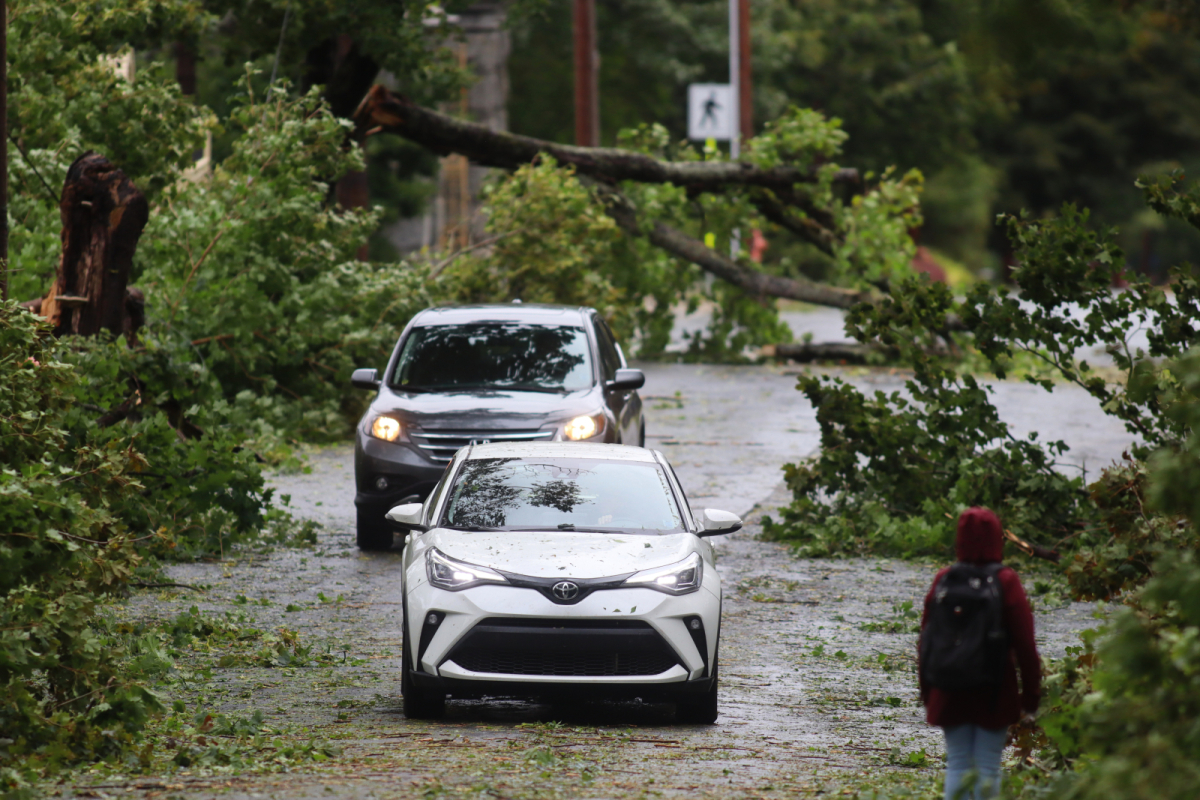Support strong Canadian climate journalism for 2025
As Atlantic Canada braces for an intense hurricane season, the region is grappling with how to protect its coastlines from future flooding and storm damage. While one province has passed landmark legislation to curb development in at-risk areas, endless delays are holding the law back while developers hurry to build before it's too late.
In Nova Scotia, all eyes are on the Coastal Protection Act, which will decide where it's safe to build new homes and buildings along the shoreline of the province as sea levels rise and climate change contributes to greater erosion and flooding. Although the act was passed in 2019, Premier Tim Houston has given no timeline on when Nova Scotians can expect the law to go into effect after multiple deadlines — and hurricanes — have passed.
Meanwhile, neighbouring Prince Edward Island is working on its new coastal zone policy. Environment Minister Steven Myers has imposed a moratorium on development near the coast, which will stay in place until the shoreline policy is complete. Newfoundland and Labrador has no similar legislation on the table but was badly damaged by hurricane Fiona: specifically, Port Aux Basques, where over 100 homes were destroyed and the town is grappling with where to allow rebuilding.
Nova Scotia should follow P.E.I.’s lead and prevent further coastal development until the act is in place, said Will Balser, coastal adaptation co-ordinator at Ecology Action Centre in Halifax. The government has said more consultation is needed before the act is put in place, but climate groups say it’s a vague excuse, as does Nova Scotia NDP Leader Claudia Chender. Chender, as reported by the Halifax Examiner, pointed to Houston being concerned about private property owners not having “access to the coast in whatever manner they want.”
Large landowners and developers on the coast are now largely unregulated, Balser said. “So, it's much faster and easier for them to put properties and developments in known erosion and flood risk areas,” said Balser.
“I also just see it as a general trend of this conservative government here of not wanting to tell anyone what to do, even if it's for our best interest.”

The Nova Scotia Department of Environment and Climate Change did not provide a timeline on the act or specifics around the delay when asked by Canada’s National Observer.
“Consultation is an essential part of public policy and government has been clear and upfront that consultation with residential coastal property owners is important. Planning for that work is happening now. The feedback we receive through this consultation will guide next steps,” the department said in a statement.
Both Nova Scotia and P.E.I. are notable: they are the only provinces in Canada with legislation of this kind on the table. In B.C., West Coast Environmental Law Society and the Canadian Parks and Wilderness Society have called for the creation of a provincial coastal strategy followed by a B.C. Coastal Protection Act, to be co-developed with Indigenous governments and co-ordinated with federal and local governments.
The Atlantic region is particularly vulnerable to climate change impacts. In Nova Scotia, there are warnings sea levels could rise a metre by 2100 if greenhouse gas emissions aren’t reduced “significantly.” Hurricanes are becoming more extreme, already causing widespread property damage.
Last fall’s hurricane Fiona was Atlantic Canada’s costliest weather event to date, which makes it all the more pressing that the Nova Scotia government put the Coastal Protection Act into place, said Balser. There is a strong financial argument to do so: the Canadian Climate Institute estimates every dollar spent on adaptation saves between $13 and $15.
“Hurricane Fiona is a really good example. It's extremely short-sighted and wasteful to spend all this money on regulations that again, as far as I'm concerned, and as far as they were concerned, two weeks into March, we're done,” said Balser.
“And now we're talking about dragging it out with more staff for two more years. All the while we're paying for hundreds of millions of dollars worth of damage every hurricane season.”
Prince Edward Island
On Prince Edward Island, the Brackley Beach and Cavendish areas of the province’s national park saw their worst damage in almost 100 years during hurricane Fiona. Before the storm, P.E.I. was already experiencing problems with erosion from waves breaking down its sand and sandstone coastline. Sea ice levels, which act as a buffer for the shoreline, have been historically low.
To recover, the province’s sand dunes require a “steady, consistent wind and wave pattern to deposit sediments over months and years,” Balser explained shortly after the storm.
The province now loses an average of 30 centimetres of land per year due to rising sea levels and stronger storms fuelled by warmer oceans: results of climate change, caused largely by the burning of fossil fuels.
The development moratorium signals the provincial government is serious about protecting the coast, explained Xander Wang, associate professor at the University of Prince Edward Island’s School of Climate Change and Adaptation. The provincial government is working with the university to develop its coastal policy and will consider recommendations from UPEI as the next step.
Ultimately, the policy should lay out where new buildings should not be constructed and recommend the best mitigation strategies for areas along the shoreline, explained Wang. He stresses it’s not as simple as a blanket rule prohibiting building close to the ocean.
“P.E.I. is very unique. We have done a lot of coastal monitoring ... you [won't] see a lot of erosion everywhere. Some areas are actually pretty safe. Other areas, you'll see maybe three or five metres of land loss a year,” he said.

The first step, which Wang is part of, is to assess policies that protect coasts to see what P.E.I. could glean from them. Longer term, the team hopes to conduct small-scale tests on different landscapes to see how they interact with waves and weather. Eventually, testing will be done on a few coastal properties to do real-time monitoring.
The researchers also want to set up a model in the lab that will be open to the public to help educate people about why co-ordinated adaptation measures are so important. Wang noted there are already people protecting their properties with big rocks, for example, but that mitigation technique can sometimes offset waves and cause more damage to neighbouring areas. Seawalls, on the other hand, protect a whole area.
“I think when people get this kind of awareness, I think at some point, everyone probably will reach a consensus. Maybe the majority at least, not everyone, I guess,” he said.
“But then it will be easier to have a discussion and public consultations through government and local communities to figure out a better solution and better policy.”






Comments
We don't get many hurricanes in coastal BC, but that's not to say we don't get some devastating storms, mainly involving low pressure cells in winter.
We are also susceptible to big earthquakes and tsunamis that can wreck parts of the southern coast where 3.5 million people live, three million in Canada's third largest metropolis alone.
There is a provincial emergency response organization but it seems to be routinely caught off guard and slow to respond when predictable emergencies actually happen. It's anybody's guess how they will respond to a once-in-a-century large scale emergency.
Trudeau showed up for a photo op when the Fraser Valley flooded a couple of years ago. It's not widely known what action the feds did take on that one.
The feds need to take a leadership role (or at least be equal partners with provinces) in long-term climate planning everywhete. Richmond, BC (pop. 230,000) is a Metro Vancouver city particularly vulnerable to sea rise being that it's highest point is currently one metre BELOW mean sea level at high tide. Dikes, diesel pumps and drainage ditches are Richmond's best friends. You have a city and some of Canada's most fertile agricultural soils on the alluvial Fraser River delta that could one day be lost.
Richmond is underlain with deep soft soil and a very high water table subject to salt water infiltration from below. Basements and underground parking structures do not exist there. The maximum building height possible given the geotechnical conditions are mid rise towers that require large "floating" slab foundations to distribute the weight over a large continuous area.
How does one plan for sea rise when taller dikes cannot be supported on the softer soil without sinking? How does one prepare for the Big One in cities built on soil that is subject to liquifaction?
Beyond tinkering with pathetically inadequate measures, Richmond and both senior governments need to think big about the long range future. If you still want a city located there, then it has to be something seemingly outrageous at first glance, like a floating city. Otherwise 230,000 people will become refugees from disaster, whether from climate or from a sudden and devastating natural event.
Maybe a planned coastal retreat is the best course of action. Sound planning and incrementally building a fund to cover a sizable portion of losses and rebuilding are cheap compared to inaction and failure to prepare. Just ask the insurance industry about that.